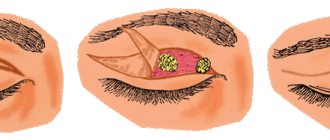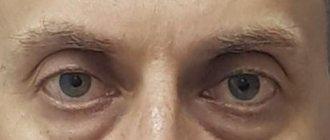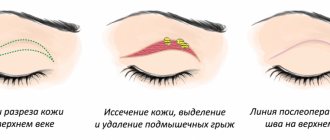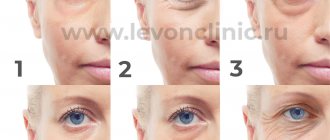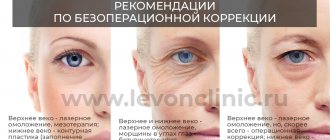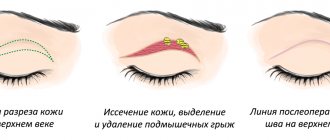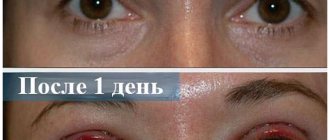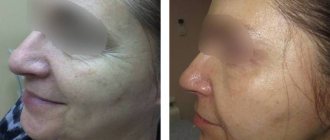We haven't talked much about transconjunctival blepharoplasty.
Meanwhile, this is one of the advanced techniques for correcting the lower eyelids.
What makes it unique? An incision is made on the conjunctiva, along the lower transitional conjunctival fold. This area is hidden, so no seams will be visible.
Moreover, you have probably heard that such blepharoplasty is called seamless. This is due to the fact that sometimes stitches are not required after the procedure.
Therefore, this type of correction is considered the most gentle.
The risk of injury in this case is minimal.
The recovery period after transconjunctival blepharoplasty is much shorter than after other types of intervention. The first part takes about ten days.
Kinds
There are several types of operations, they depend on the execution and purpose:
- lower eyelid surgery;
- upper eyelid surgery;
- Circular operations are performed simultaneously on both the upper and lower eyelids.
Transconjunctival blepharoplasty on the lower eyelids is performed to eliminate swelling and hernias, which gives the patient a tired appearance.
This type of intervention has purely cosmetic purposes.
Surgery on the upper eyelids is performed to remove excess area; this may be necessary to improve visual acuity; the procedure is prescribed by an ophthalmologist.
Other types of transconjunctival blepharoplasty:
- correction of Asian eye shape (epicanthus);
- correction of drooping corners of the eyes;
- treatment of a bulging eyeball.
At what age is it better to do it?
If you are concerned about such tissue sagging, it makes sense to think about surgery at an early stage, when the body’s reserve and recovery capabilities are still quite large. However, older patients who have retained sufficiently elastic skin around the eyes can also count on minimally invasive intervention.
How to determine if this method of facial rejuvenation is right for you, where to start?
It's simple. Consult a good plastic surgeon.
Ask a Question
Indications
Indications for transconjunctival blepharoplasty:
- congenital or acquired defects in the eyelid area;
- lower eyelid hernia;
- stretching of the skin of the paraorbital area;
- correction of ptosis;
- bags under the eyes;
- heavy eyelid syndrome;
- aging eyelid;
- drooping upper eyelid;
- excess fat under the skin on the lower eyelids;
- correction of poor eye shape;
- drooping corners of the eyes;
- presence of deep wrinkles.
In rare cases, the operation is prescribed for therapeutic purposes; most often, blepharoplasty is performed at the request of the patient himself - he may be bothered by cosmetic defects that cause psychological discomfort, but do not have an impact on health.
How is transconjunctival blepharoplasty performed?
During the operation, I inject an anesthetic, bend the edge of the eyelid and make a small incision on its inner surface. The length of the wound usually does not exceed 0.5 cm. Excess adipose tissue is removed through it, and its remainder is evenly distributed under the skin. Next, I treat the wound with an antiseptic. If the duration of the incision does not exceed half a centimeter, no stitches are applied. The defect is healed by the mucous membrane on its own. This reduces postoperative discomfort in the damaged area and accelerates regeneration.
Contraindications
Contraindications to transconjunctival blepharoplasty:
- any acute diseases and chronic pathologies in aggravation;
- menstruation in women;
- "dry" eye;
- high intraocular pressure;
- high blood pressure;
- diabetes;
- systemic blood diseases;
- oncological diseases;
- thyroid diseases;
- blood clotting disorders;
- immunodeficiency conditions, including AIDS and HIV.
Advantages and disadvantages of the technique
The undoubted advantages of the operation are:
- No need for general anesthesia. The patient feels quite comfortable with local anesthesia.
- Minor infestation. The surgeon makes punctures or micro-incisions along the line of the conjunctiva, uses self-absorbing suture material, or leaves the injured area to heal itself.
- Complete rehabilitation after surgery occurs within 10 days. The patient can return to normal activities on the 8th day, in rare cases - on the 11th.
- Long lasting effect. The result lasts from 6 to 12 years. The period depends on the patient’s age, skin elasticity, and lifestyle.
- Minimal risk of complications.
- No scars.
But blepharoplasty, like transconjunctival eyelid surgery, has a significant drawback - the inability to eliminate severely stretched skin. To solve the problem it is necessary to excision it. Getting rid of dark circles under the eyes is also not always possible.
Advantages
The transconjunctival blepharoplasty method has a number of undeniable advantages, which makes it attractive to patients:
- low morbidity during the operation;
- absence of stitches in the area of the eyelid where blepharoplasty was performed;
- a short rehabilitation period, it lasts only 7–10 days, after this period the swelling of the eyelids completely disappears;
- low risk of complications;
- the result of surgery looks natural.
Your questions
How long will the effect of the operation last? It depends on the patient himself. After all, the skin sags and loses tone not only due to age and genetic characteristics. Lifestyle is also of great importance: night work, lack of sleep, chronic fatigue do not have the best effect on the quality of the skin. Taking care of yourself is the main secret of youth and beauty.
Is there a best time of year to have blepharoplasty? The myth about the time of year came quite recently and is not substantiated by anything. The time of year does not affect the operation itself, the rehabilitation period, or the final result.
Which method do you use for transconjunctival blepharoplasty: redistribution or removal of hernias? During transconjunctival plastic surgery of the lower eyelids, I partially remove fatty hernias and partially redistribute them. Everything is very individual and depends on the specific situation.
Preparation
Transconjunctival blepharoplasty is a low-traumatic operation, but even this procedure requires preoperative examination and preparation, as well as consultation with an ophthalmologist.
What the patient needs to do before the operation:
- pass all tests - general urinalysis, biochemical and general blood tests;
- stop taking non-steroidal anti-inflammatory drugs at least 3 weeks in advance;
- give up natural tanning, as well as solariums two weeks before the proposed operation;
- 14 days before transconjunctival blepharoplasty, the patient should stop drinking alcohol;
- plan your affairs for 3-7 days so as to ensure a full recovery after the operation;
- Be sure to consult with an ophthalmologist, especially if there are any vision problems or eye diseases.
results
The length of time the results are maintained depends both on the technique of the operation itself and on the patient’s lifestyle. On average, transconjunctival blepharoplasty gives results for 7-10 years.
Transconjunctival blepharoplasty of the lower and upper eyelids
Carrying out the operation
Transconjunctival blepharoplasty does not last long - all manipulations usually do not exceed 1-1.5 hours. The procedure on both the lower and upper eyelids is performed under local anesthesia; it ensures complete painlessness for the patient for the entire period of the surgical operation. After blepharoplasty, the patient is released from the hospital within five to seven hours.
When performed, transconjunctival blepharoplasty is carried out using two methods, the first is the use of the traditional scalpel method, the second method is based on the use of a cutting laser, it is also called laser blepharoplasty.
Upper eyelid blepharoplasty
During upper eyelid surgery, the specialist makes an incision on the inside of the eyelid, cutting through the conjunctiva. Then the doctor inserts an endoscope into the incision, with its help he tightens the eyebrows; this action allows you to remove overhanging folds, as well as model the desired shape of the eyebrows.
To prolong the effect for a long time, implants can be used in some cases; as a rule, they are used in elderly patients, since at this age the skin is not elastic enough.
After the operation there are no stitches left, the result is not noticeable and looks natural.
Transconjunctival blepharoplasty of the lower eyelid
During lower eyelid surgery, the surgeon makes an incision behind the eyelash line without making additional external incisions. The fat sac is then removed from the inside of the eye. After the operation, patients also do not have scars or other visible signs of the operation.
Video
Example of transconjunctival blepharoplasty
Cost of transconjunctival blepharoplasty
| Name | Price |
| Surgical correction of the lower eyelids transconjunctivally | 75,000 rub. |
| Primary appointment (examination, consultation) with a plastic surgeon | FOR FREE |
Postoperative period
The postoperative period after transconjunctival blepharoplasty is no more than 10 days, during this time you should not be afraid of the appearance of swelling, discomfort in the eyes, irritation - all these are natural reactions of the body that go away on their own and do not cause unpleasant consequences, but you should adhere to certain rules:
- for two weeks the patient should not sunbathe outdoors or go to the solarium;
- It is not recommended to use contact lenses for three weeks;
- after the operation, you should not take a very hot shower for a month; baths and saunas should be avoided;
- in the first week it is recommended to limit physical activity; you will have to postpone cleaning, reading books, watching television programs, and playing sports;
- You should wear sunglasses for three months;
- You can use hypoallergenic cosmetics eight days after surgery;
- a week after the operation you can already go to work, and the stitches are removed 2-6 days after blepharoplasty.
Transconjunctival blepharoplasty is the most gentle surgical method for correcting cosmetic defects; many patients note the effectiveness and high positive results after the procedure.
Recovery after the procedure
There is practically no rehabilitation period. Hematomas and swelling disappear after a few days, although most patients only feel discomfort. After a week, the stitches are removed, and after a month you can see the final result.
In the first few weeks after the procedure, you should not be in direct sunlight, wear contact lenses, or strain your eyes with TV and computers. It is also recommended not to visit baths, saunas and solariums.
The price for transconjunctival blepharoplasty at the Arnovel clinic depends on the complexity of the case. Make an appointment with a plastic surgeon. He will conduct an examination and tell you the cost of the operation.
Possible complications after transconjunctival blepharoplasty
In the vast majority of cases, the operation does not cause unpleasant consequences. In rare cases, complications are possible:
- suppuration in the operated area;
- hematomas;
- pigmentation disorder;
- eversion or drooping of the eyelid;
- bruising on the whites of the eyes;
- infection;
- hollows under the eyes after manipulation of the lower eyelids.
Consequences can be caused by unskilled work of the surgeon and non-compliance by the patient with the rules of the recovery period. But final conclusions about the result of the procedure can be made only after two months.
